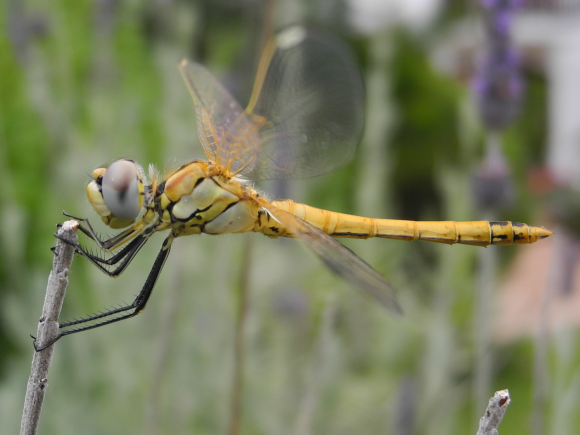Genus Sympetrum Newman, 1833
true darters
Type species: Libellula vulgata Linnaeus, 1758
Introduction
Although a few range into tropical America, Africa and Asia, the vast majority of the over 50 species are Holarctic. Four of the latter extend from Europe in north-western Africa, but with two former Sympetrum species separated in Trithetrum, only one remains known in tropical Africa: known as the Red-veined Darter in Europe, the Nomad (S. fonscolombii) ranges from Japan to the Cape, breeding in exposed pools and lakes. It is nomadic and erratic in occurrence. In Africa it occurs mostly in drier and higher areas, being absent from much of western and central Africa, but locally common from Kenya north toward the Sahara and from Zimbabwe southward. The mature male is a medium-sized (hindwing 26-31 mm) red dragonfly recalling Crocothemis and Trithemis, but the fine black markings, white-sided red face, and whitish side-stripes on the thorax are distinctive. [Adapted from Dijkstra & Clausnitzer 2014]
Diagnosis
Male of genus is similar to Trithetrum by (a) size, Hw 23-35 mm; (b) all wings with 0 cell-doublings in radial planate [0-2]; (c) Pt never black-and-white and wings at most with dark tips or bases or with overall yellowish infusion; (d) Fw supratriangles without cross-veins; (e) Fw triangle of 2-3 cells, subtriangle of 3-6 cells; (f) Fw discoidal field of 3-4 rows at base; (g) 6½-8½ Ax in Fw; (h) arculus between Ax1-2, usually closest to Ax1; (i) if Abd ventrally red or orange, then dorsum similarly coloured. However, differs by (1) body parts with distinct markings: thorax with black lines on sutures; frons with basal black band; mid and hind femur black with pale streaks; at least S1 and S8-9 marked with black; (2) venation yellow to red, rather than blackish; (3) Fw discoidal field 3-4 cells wide on wing border. [Adapted from Dijkstra & Clausnitzer 2014; this diagnosis not yet verified by author]

Sympetrum sinaiticum Dumont, 1977. © Jean-Pierre Boudot

Sympetrum fonscolombii (Selys, 1840). Male (young) © Damian Pinguey
Map citation: Clausnitzer, V., K.-D.B. Dijkstra, R. Koch, J.-P. Boudot, W.R.T. Darwall, J. Kipping, B. Samraoui, M.J. Samways, J.P. Simaika & F. Suhling, 2012. Focus on African Freshwaters: hotspots of dragonfly diversity and conservation concern. Frontiers in Ecology and the Environment 10: 129-134.
References
- Dijkstra, K.-D.B., and Lewington, R. (2006). Field guide to the Dragonflies of Britain and Europe. British Wildlife Publishing, 1-320.
- Ris, F. (1921). The Odonata or Dragonflies of South Africa. Annals South African Museum, XVIII, 245-452. [PDF file]
- Pinhey, E.C.G. (1961). Dragonflies (Odonata) of Central Africa. Occasional Papers Rhodes-Livingstone Museum, 14, 1-97. [PDF file]
- Barnard, K.H. (1937). Notes on dragon-flies (Odonata) of the S. W. Cape with descriptions of the nymphs and of new species. Annals South African Museum, 32, 169-260. [PDF file]
Citation: Dijkstra, K.-D.B (editor). African Dragonflies and Damselflies Online. http://addo.adu.org.za/ [2024-10-30].

